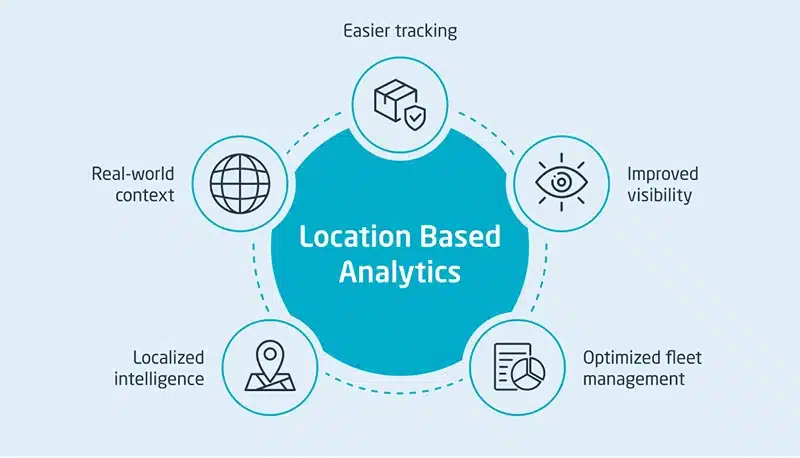
The importance of analytics influenced by geographic phenomena has advanced tremendously due to developments in location-based analytics. This is valuable for construction developers creating more modern frameworks, for advanced tech start-ups, as well as for real estate analysts estimating the value of residential and commercial properties.
The reason behind this growth is best described by the phrase “big data”. With the increasing amount of digitized information being provided by mobile devices, social media check-ins, GPS signals, and IoT sensors, businesses have access to an ever-growing volume of data sets with real-time information regarding location-based activities. This data can provide valuable insights for businesses including optimizing supply chains, analyzing consumer behavior patterns, predicting real estate price changes, etc.
It is important to note that while big data augments location-based data analytics, it does come with certain challenges. Factors such as the accuracy of the data obtained, data privacy, and integration complexity all impact how location-based analytics are deployed by businesses. In this article, we address the influence of big data in this industry, the challenges for businesses, and the prospects waiting in the wings.
The Impact of Big Data on Location-Based Analytics

Image Source: Calamp
Location-based analytics in organizations has completely transformed due to big data. In the past, businesses performed geographic analysis using datasets from surveys and census data because it was all that was accessible.
Now, with the advent of new technologies, people are able to access vast amounts of data streams that are updated in real-time which helps businesses make informed decisions regarding geographic trends.
1. Hyper-Accurate Insights for Real Estate and Urban Planning
Big data considerably changes how analysts view real estate valuation. In the past, real estate value was estimated based on historical sales, basic details about the property, and neighborhood demographics. Nowadays, satellite imagery, local business traffic, real-time traffic patterns, and even air quality are considered. For example, a study by McKinsey found that using location-based analytics can improve property value predictions by up to 15%, giving real estate professionals a more accurate view of market trends.
Big data helps urban planners gain valuable insights about how people utilize and move through the city. Mobile data heat maps help display regions that experience high traffic volume and this can assist in optimizing public transport and infrastructure development.
2. Predictive Analytics for Market Trends
Considered one of the most beneficial aspects of big data in location-based analytics is the ability to forecast market trends. Retail chains, for example, use foot traffic data to analyze customer trends and change store placements accordingly. Likewise, Real estate investors can study the historical changes in property prices, along with other relevant socioeconomic indicators, to make more informed decisions.
3. Improving Customer Targeting with Geospatial Data
Customer data reveal powerful insights previously unavailable to businesses. Through geospatial analysis, firms can execute more precise marketing campaigns corresponding to the customers’ places of residence, workplaces, and areas where they spend most of their time. A PropTech startup can target users with property recommendations personalized according to their commuting habits and lifestyle choices that are captured through location data.
4. Optimizing Supply Chains and Logistics
Big data-powered location-based analytics solutions enhance the efficiency of E-commerce and logistics businesses. Real-time monitoring of delivery vehicles enables prediction of traffic conditions and optimizing warehouse locations based on demand hotspots. According to a report by PwC, businesses that use location intelligence in logistics have seen operational costs drop by up to 20%.
Challenges of Using Big Data in Location-Based Analytics
Integrating big data into location-based analytics has its challenges, despite the wonderful benefits that location-based analytics can offer.
1. Data Accuracy and Quality Issues
Obtaining data accuracy and consistency is already a Herculean task, what more for combining numerous datasets? The concerns that arise from unverified sources, including the insights that stem from them, need attention always. Mobile devices, for example, sometimes inaccurately predict where a user is due to signal interference which misleads the insights that can be gained from GPS data.
2. Privacy and Data Security Concerns
These days, as more and more businesses are able to track the data of their customers, privacy concerns are a growing matter. People have become concerned with how data is used and as a result, the government has imposed tighter laws such as GDPR and CCPA. Location-based analytics providers need to ensure that they are not only compliant with the regulations of their respective countries but have proper measures of data safeguard too.
3. Integration of Disparate Data Sources
Location-based analytics incorporate data coming from various satellites, IoT devices, mobile applications, etc. These data streams into a single unified framework for processing and advanced analytics. Data silos are a big obstacle for many businesses where different functional units in a company have separate datasets that are not inter-departmentally accessible.
4. High Processing and Storage Costs
The processing of spatial datasets requires sophisticated computing equipment. Operational expenses tend to be high for smaller firms when storing or processing real-time geospatial information. Cloud solutions for location-based data analytics aid in decreasing this burden, but a significant level of investment in the right resources and technologies is still required.
How Web Scraping Powers Location-Based Analytics
Data accuracy and being up-to-date is a core problems when considering location-based analytics. Traditional data sources such as government documents and market reports can be helpful but are often stale almost immediately. This outlines the importance of web scraping.
1. Real-Time Property and Market Data Collection
Access to new listings, rental prices, and other relevant market intelligence is crucial for real estate analysts and valuation firms. Web scraping technology enables the collection of data from several property listing portals which assists the analysts to track the price changes, demand trends, and the emerging hotspots in the real estate industry.
2. Competitive Intelligence for Startups
Traffic, customer reviews, and business directories are common sources of data for location intelligence. Retailers apply location-based analytics during site selection, competitor benchmarking, and consumer behavior analysis. From the data collected, companies can strategically place new stores in areas where there is demand but little or no supply.
3. Geospatial Sentiment Analysis from Social Media & Reviews
Social media sentiment analysis is becoming ever more crucial as real estate pricing and business success are significantly affected by consumer sentiment. The web offers reviews, social media check-ins, and even local conversations about certain locations. Such sentiments can be helpful for real estate companies trying to determine the appeal of a specific neighborhood or for retail businesses assessing brand sentiment in certain regions.
4. Tracking Infrastructure and Development Trends
The construction and development of urban infrastructure like commercial centers, new highways, or even metro stations has a profound effect on property value and business growth. Web scraping can aid in tracking urban development plans, government announcements, and news coverage to capitalize on new investment possibilities.
5. Enhancing Accuracy with Multi-Source Data Aggregation
Single-sourced data is not optimal for location-based analytics as it is highly susceptible to bias or incomplete insights. Information scraping provides the means to gather data from multiple sources, thereby enhancing the precision and dependability of the information intelligence gleaned. Merged real estate listings and government records of transactions serve as examples of improving the accuracy of property valuation models by scraping data to build them.
Opportunities for Businesses and Professionals
Ignoring the challenges posed by these opportunities is hard to resist when it comes to location-based analytics. There is ample opportunity in these analytics, especially for those real estate businesses willing to tap into big data for easier access to up-to-date information.
1. AI and Machine Learning for Smarter Insights
The progress of AI and machine learning technologies makes it increasingly easier to derive valuable insights from location data. Geospatial analytics can enable property valuation companies to more accurately assess future property prices through AI-powered location-based valuation models. Moreover, predictive analytics models can identify trends in geospatial data, assisting businesses in forecasting their data.
2. Real-Time Decision Making
Uber and other ride-hailing services utilize real-time geolocation data to instantly connect drivers with passengers. This is one of the drivers why businesses that use geolocation data analytics can make data-driven decisions in a matter of seconds. Retailers can also change prices in real time based on the demand in their immediate surroundings.
3. Smarter Investment Strategies for Real Estate
Using location-based analytics, real estate investors and analysts will gain an unprecedented advantage in market intelligence. They will no longer be confined within the walls of traditional valuation methods as they will have the ability to make smarter investments by analyzing footfall, economic growth, and even social sentiment data.
4. Enhancing Customer Experience with Personalization
With location-based analytics, businesses are able to improve customer experiences on an entirely new level. Retailers can push regional discounts to customers who are near their outlet, and PropTech startups can provide hyper-personalized property searching experiences.
The Role of PromptCloud in Location-Based Data Extraction
Specializing in location-based data extraction from the web, PromptCloud offers structured web data extraction services. From real estate analytics, business sentiment analysis, and customer sentiment analysis, organizations can implement location-based analytics solutions to drive valuable insights with web scraping technology.
With advancements in geospatial analytics tools, web-scraped data can be integrated which enables deeper insights, real-time decision-making, and predictive abilities to stay ahead of competitors.
Conclusion
The coming of big data has greatly enhanced location-based analytics which has, in turn, provided new opportunities for real estate analysts, PropTech start-ups, and various other businesses. Industries big or small gain the ability to leverage big data for market insights and predictive analytics.
Still, the issues of data accuracy, privacy, and integration have to be tackled. Companies need to adopt sophisticated analytics approaches while maintaining compliance with regulations and creating robust AI solutions to overcome these challenges and maximize the impact of location-based analytics.
The pace at which technology is growing makes it easy to anticipate the future of geo-data analytics with advancements in AI tools and regulatory-compliant analytics infrastructure which makes it even more efficient. Innovators that utilize data-driven insight will change the way humans interact with the world.Contact us today at sales@promptcloud.com.


















